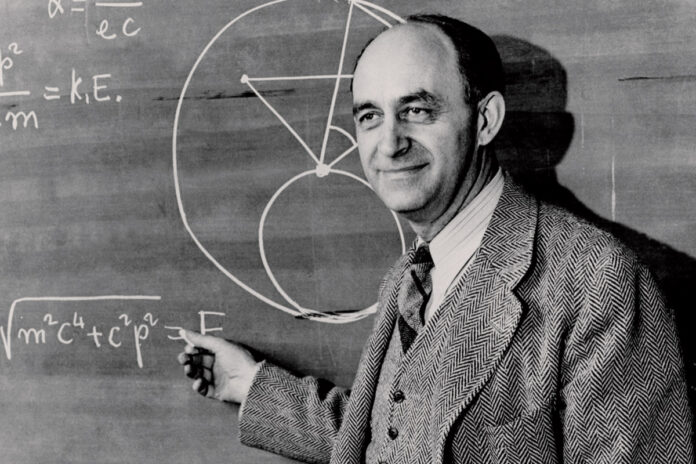Enrico Fermi, one of the most renowned physicists of the 20th century, made groundbreaking contributions to nuclear physics, quantum theory, and statistical mechanics. Known for his work on the development of the first nuclear reactor and his role in the Manhattan Project, Fermi’s influence on science and technology is profound. This article delves into Fermi’s life, his significant contributions, and his enduring legacy.
Early Life and Background
Birth and Family
Enrico Fermi was born on September 29, 1901, in Rome, Italy, to Alberto Fermi, a railway division head, and Ida de Gattis, an elementary school teacher. From a young age, Fermi displayed an exceptional aptitude for mathematics and science. Encouraged by his family, he pursued his passion for learning, which would eventually lead him to become one of the foremost physicists of his time.
Education and Early Influences
Fermi’s early education was marked by his insatiable curiosity and prodigious talent. He studied at the Scuola Normale Superiore in Pisa, where he earned his doctorate in physics in 1922. His doctoral thesis focused on X-ray diffraction, laying the groundwork for his future research. Fermi was deeply influenced by the works of Albert Einstein, Paul Dirac, and Niels Bohr, which shaped his understanding of quantum mechanics and atomic theory.
Career and Scientific Contributions
Early Career and Quantum Theory
After completing his doctorate, Fermi spent time at the University of Göttingen and the University of Leiden, where he interacted with prominent physicists and expanded his knowledge. In 1926, he returned to Italy to accept a professorship at the University of Rome. During this period, Fermi developed the Fermi-Dirac statistics, a quantum statistical model that describes the behavior of particles that obey the Pauli exclusion principle. This groundbreaking work laid the foundation for the study of electron behavior in atoms and solids.
Development of Beta Decay Theory
In the early 1930s, Fermi proposed a theoretical framework for beta decay, a type of radioactive decay in which a beta particle (electron or positron) is emitted from an atomic nucleus. Fermi’s theory incorporated the concept of the weak nuclear force, one of the four fundamental forces in nature, and introduced the neutrino, a neutral subatomic particle. This theory was pivotal in advancing our understanding of radioactive processes and particle physics.
Discovery of Artificial Radioactivity and Neutron Bombardment
Fermi’s experiments with neutron bombardment in the mid-1930s led to the discovery of artificial radioactivity. By bombarding various elements with neutrons, Fermi and his team induced radioactivity in previously stable elements. This work was crucial in the development of nuclear physics and earned Fermi the Nobel Prize in Physics in 1938. The discovery of neutron-induced radioactivity also paved the way for the development of nuclear reactors and atomic energy.
Emigration to the United States
Political Climate and Emigration
The rise of Fascism and anti-Semitic laws in Italy during the 1930s prompted Fermi to emigrate. Although Fermi himself was not Jewish, his wife, Laura Capon, was, and the Fascist regime’s policies posed a direct threat to their family. In 1938, after receiving the Nobel Prize in Stockholm, Fermi and his family emigrated to the United States, where he accepted a professorship at Columbia University.
Contributions to the Manhattan Project
Fermi’s move to the United States marked the beginning of a new chapter in his career. In 1942, he joined the Manhattan Project, the top-secret U.S. government research initiative aimed at developing atomic weapons during World War II. Fermi played a crucial role in the project, particularly in the construction and operation of the first nuclear reactor, Chicago Pile-1. On December 2, 1942, Fermi successfully initiated the first controlled nuclear chain reaction, a milestone in the development of nuclear energy and weapons.
Development of the First Nuclear Reactor
The successful operation of Chicago Pile-1 demonstrated the feasibility of nuclear reactors and laid the groundwork for the development of nuclear power. Fermi’s expertise in neutron physics and his innovative approach to reactor design were instrumental in this achievement. The reactor’s success also underscored the potential for harnessing nuclear energy for both civilian and military purposes.
Major Achievements and Awards
Nobel Prize in Physics
Fermi’s groundbreaking work on neutron-induced radioactivity and his contributions to nuclear physics earned him the Nobel Prize in Physics in 1938. The Nobel Committee recognized his “demonstrations of the existence of new radioactive elements produced by neutron irradiation, and for his related discovery of nuclear reactions brought about by slow neutrons.”
Other Prestigious Awards
In addition to the Nobel Prize, Fermi received numerous other prestigious awards and honors, including:
- Franklin Medal (1947): Awarded by the Franklin Institute for his contributions to physics.
- Hughes Medal (1942): Awarded by the Royal Society for his work on nuclear physics.
- Rumford Prize (1953): Awarded by the American Academy of Arts and Sciences for his discoveries in thermodynamics and nuclear energy.
Later Years and Legacy
Teaching and Mentoring
After World War II, Fermi continued his work in nuclear physics and became a professor at the University of Chicago. He was known for his exceptional teaching skills and his ability to inspire and mentor young scientists. Many of his students, including Nobel laureates such as Owen Chamberlain and Leon Lederman, went on to make significant contributions to physics.
Contributions to Particle Physics
In his later years, Fermi made important contributions to particle physics, particularly in the study of high-energy particles and cosmic rays. His work on the Fermi paradox, which questions the apparent absence of extraterrestrial civilizations despite the vastness of the universe, continues to intrigue scientists and philosophers.
Death and Commemoration
Enrico Fermi passed away on November 28, 1954, at the age of 53, due to stomach cancer. His death was a significant loss to the scientific community, but his legacy endures through his numerous contributions to physics and the many scientists he inspired. Fermi’s name is commemorated in various ways, including the element fermium (atomic number 100), the Fermi National Accelerator Laboratory (Fermilab), and the Fermi Gamma-ray Space Telescope.
Impact on Science and Technology
Development of Nuclear Energy
Fermi’s work on nuclear reactions and reactor design was instrumental in the development of nuclear energy. The principles he established are still used in modern nuclear reactors, which provide a significant portion of the world’s energy. His contributions to the understanding of nuclear fission also paved the way for advancements in medical imaging, cancer treatment, and other applications.
Influence on Modern Physics
Fermi’s contributions to quantum mechanics, statistical mechanics, and particle physics have had a lasting impact on the field of modern physics. His theoretical and experimental work laid the foundation for many of the advances in these areas. The Fermi-Dirac statistics, Fermi’s golden rule, and Fermi’s interactions remain fundamental concepts in physics today.
Legacy as a Pioneer and Innovator
Enrico Fermi is remembered as a pioneer and innovator who pushed the boundaries of scientific knowledge. His ability to bridge theory and experiment, coupled with his relentless curiosity and intellectual rigor, set a high standard for scientific research. Fermi’s legacy is reflected in the numerous awards, institutions, and scientific concepts that bear his name.
Personal Life and Character
Family and Personal Relationships
Fermi was known for his close relationship with his family, particularly his wife, Laura, and their two children, Nella and Giulio. Laura Fermi, herself an accomplished writer, provided invaluable support throughout his career. Fermi’s personal letters and writings reveal a man of great humility, kindness, and dedication to both his family and his work.
Intellectual Curiosity and Pragmatism
Fermi’s intellectual curiosity and pragmatism were defining aspects of his character. He approached scientific problems with a practical mindset, often devising simple yet elegant solutions. This pragmatism earned him a reputation as a “physicist’s physicist” and made his insights particularly valuable to both theorists and experimentalists.
Commitment to Education and Public Service
Fermi’s commitment to education and public service extended beyond his research and teaching. He was an advocate for the peaceful use of nuclear energy and worked to promote scientific literacy among the public. Fermi’s efforts to bridge the gap between science and society reflect his belief in the importance of knowledge and its application for the greater good.
FAQs
1. What are some of Enrico Fermi’s most significant discoveries?
Enrico Fermi’s most significant discoveries include the development of Fermi-Dirac statistics, the theory of beta decay, the discovery of artificial radioactivity through neutron bombardment, and the construction of the first nuclear reactor, Chicago Pile-1.
2. How did Enrico Fermi influence the development of nuclear energy?
Enrico Fermi influenced the development of nuclear energy through his pioneering work on nuclear reactions and reactor design. His successful demonstration of a controlled nuclear chain reaction laid the foundation for the development of nuclear power plants and the broader use of nuclear energy.
3. What awards and recognitions did Enrico Fermi receive?
Enrico Fermi received numerous awards and recognitions, including the Nobel Prize in Physics (1938), the Franklin Medal (1947), the Hughes Medal (1942), and the Rumford Prize (1953). He was also commemorated with the naming of the element fermium, Fermilab, and the Fermi Gamma-ray Space Telescope.
4. How did Fermi’s early life and challenges shape his career?
Fermi’s early life and challenges, including his rigorous education and the political climate in Italy, shaped his career by fostering a deep passion for physics and a determination to pursue scientific excellence. His emigration to the United States allowed him to continue his groundbreaking research in a supportive environment.
5. What is Enrico Fermi’s lasting legacy?
Enrico Fermi’s lasting legacy is his extraordinary contribution to the fields of nuclear physics, quantum theory, and statistical mechanics. His work laid the foundation for modern physics and nuclear energy, and his influence continues to inspire scientists and educators worldwide.
Conclusion
Enrico Fermi’s contributions to science and his enduring legacy are unparalleled. His groundbreaking work in nuclear physics, quantum theory, and statistical mechanics revolutionized our understanding of the physical world. From his early theoretical advancements to his pivotal role in the development of the first nuclear reactor, Fermi’s journey is a testament to his brilliance and dedication. His achievements continue to inspire and influence scientists, educators, and thinkers worldwide. As one of Italy’s greatest scientific legends, Enrico Fermi’s legacy will endure for generations to come, ensuring that his name remains synonymous with the pursuit of knowledge and the advancement of science.

